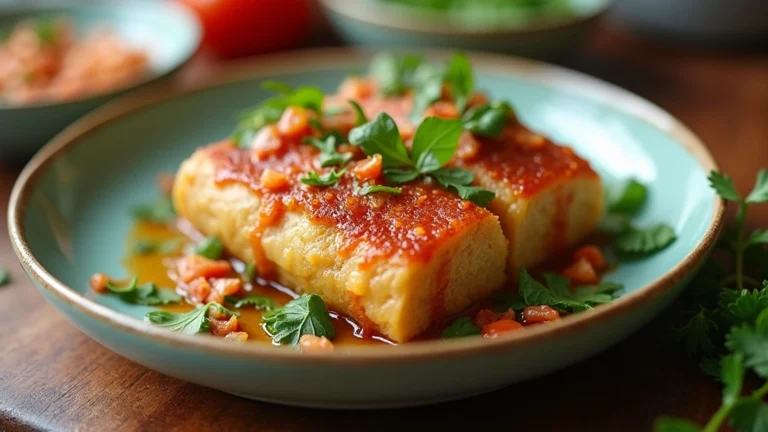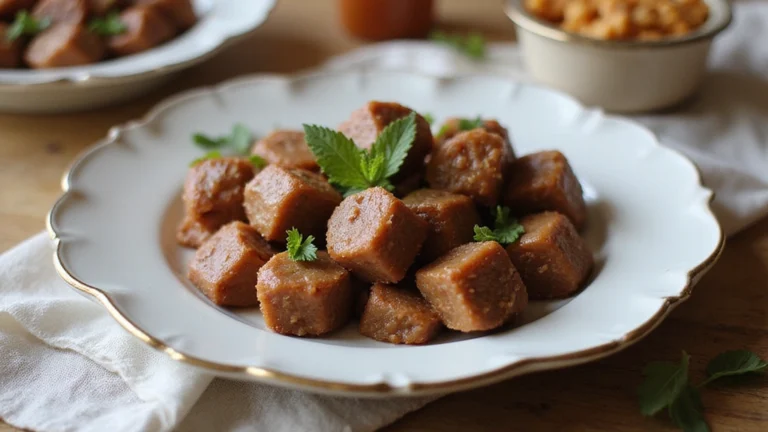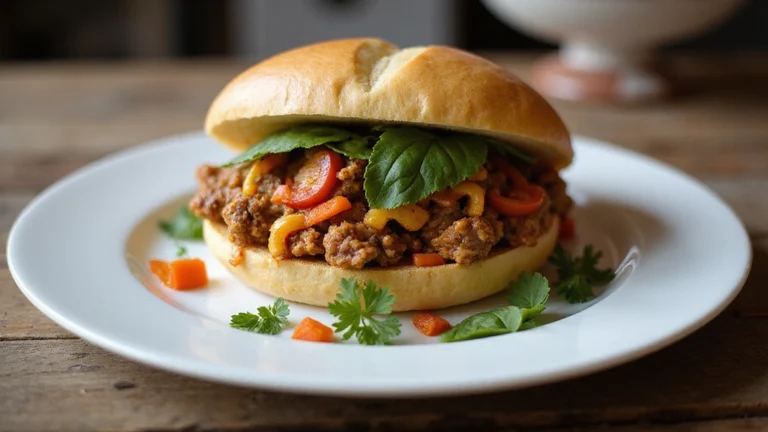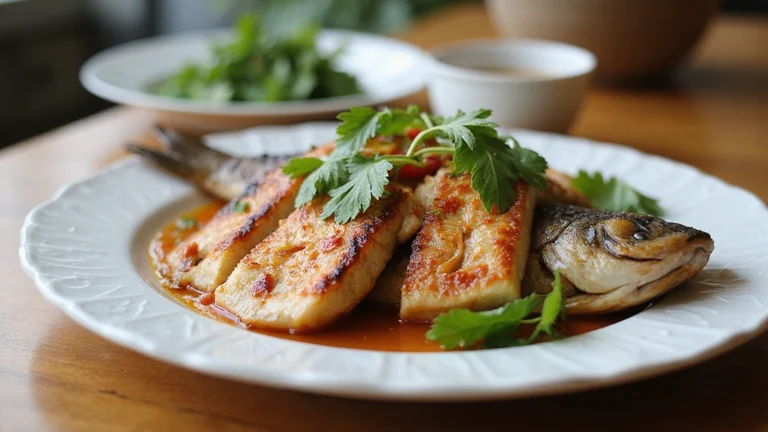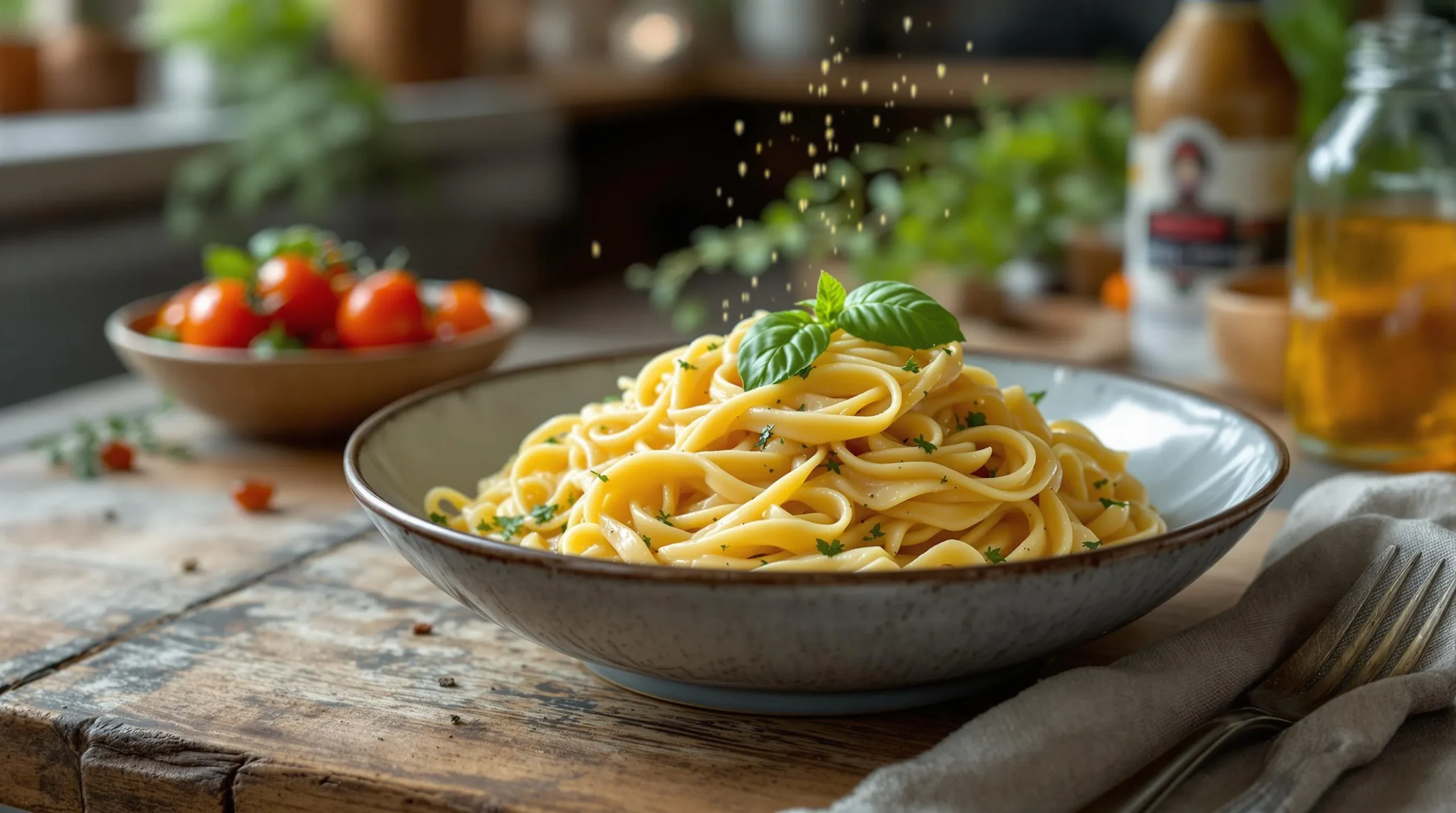
What Is Garlic Confit?
Garlic confit is a culinary technique where whole garlic cloves are slowly poached in oil at a low temperature until they become incredibly tender soft and develop a rich mellow flavor. The term “confit” comes from the French word “confire” which means “to preserve.” Unlike raw garlic’s sharp pungent bite garlic confit offers a sweet buttery taste profile that transforms any dish it touches.
The slow cooking process fundamentally changes garlic’s chemical composition breaking down the compounds responsible for its harsh characteristics. Your garlic cloves will become spreadably soft with a texture similar to roasted garlic but with an even more luxurious mouthfeel. This transformation happens as the garlic releases its natural sugars and oils into the surrounding fat creating a delectable infusion.
Many home cooks discover garlic confit as a revelation. Liam often mentions how his first taste of garlic confit pasta at a small Italian restaurant in Florence changed his entire perspective on what garlic could be. “The cloves melted into the pasta creating this velvety sauce that coated every strand perfectly” he recalls. “It was nothing like the sharp garlic flavor I was used to.”
The infused oil becomes equally valuable as the garlic itself serving as a flavor-packed cooking medium you can use for weeks afterward. Store your garlic confit properly in the refrigerator and you’ll have an instant flavor enhancer ready for countless dishes beyond pasta.
Why You’ll Love This Garlic Confit Pasta
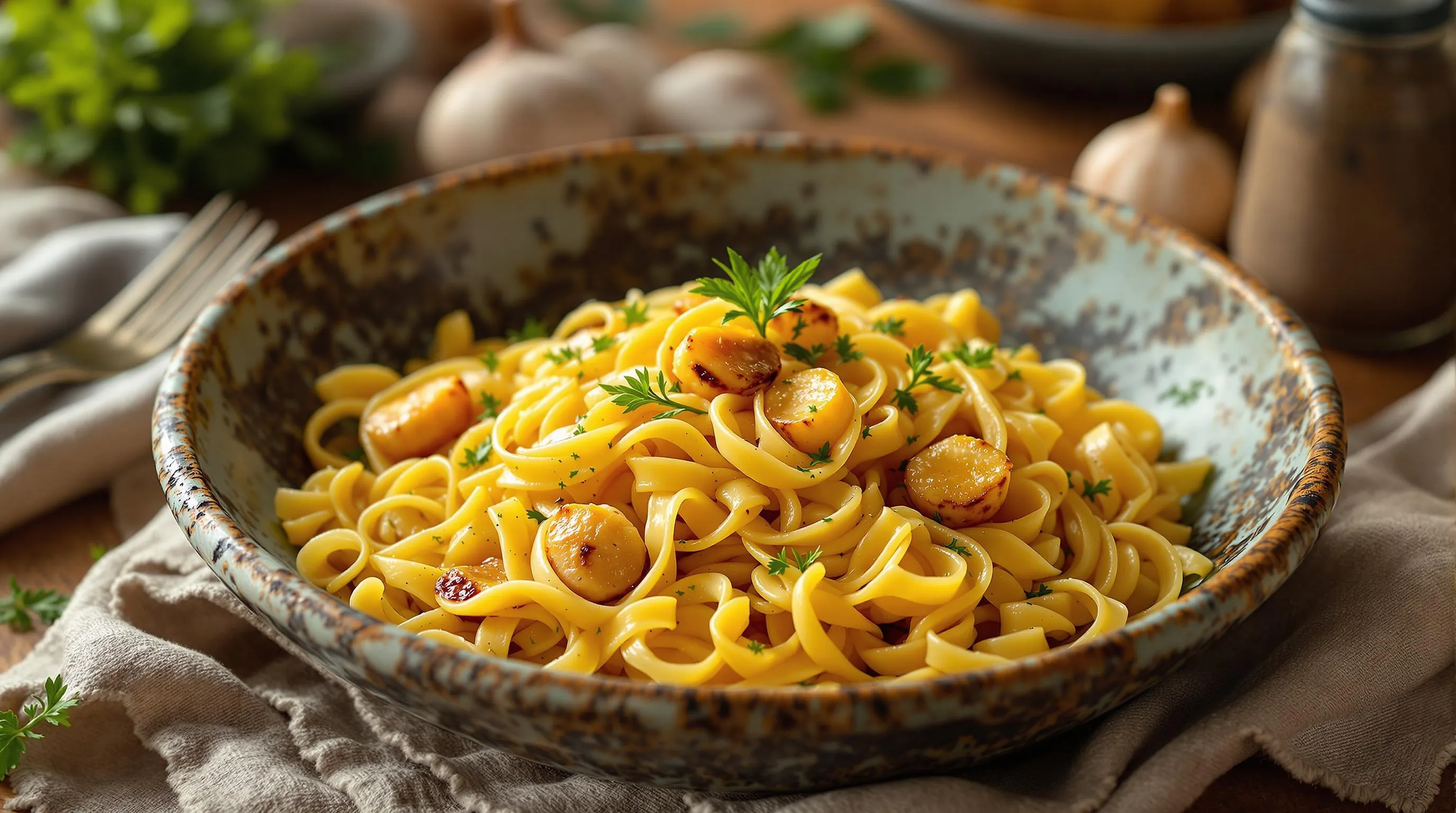
This garlic confit pasta will quickly become your new favorite comfort food for countless reasons. The star of this dish is undoubtedly the slow-cooked garlic which transforms from sharp and pungent to remarkably sweet and buttery through the gentle cooking process. Unlike raw garlic with its harsh bite, these golden cloves melt into a spreadable consistency that creates a velvety sauce coating every strand of pasta.
The rich, mellow garlic flavor stands at the forefront of this recipe’s appeal. Through slow roasting in olive oil, the garlic loses all its bitterness while developing complex sweet notes that elevate the entire dish. The infused oil itself becomes a culinary treasure, packed with aromatic compounds that would enhance any meal.
You’ll appreciate the impressive versatility this recipe offers. The garlic confit and its infused oil pair beautifully with various ingredients—blend with roasted cherry tomatoes for a rustic sauce or incorporate cream for a luxurious finish. This adaptability allows you to customize the dish to your preferences or use whatever ingredients you have on hand.
Busy weeknights call for simple preparation, and this pasta delivers exactly that. With just basic ingredients—garlic, olive oil, fresh herbs, and your pasta of choice—you can create a restaurant-worthy meal without complicated techniques or hard-to-find components. The hands-off cooking process gives you time to handle other tasks while your kitchen fills with enticing aromas.
Beyond its extraordinary flavor, this pasta brings impressive health benefits to your table. Garlic functions as a natural antibiotic and contains many antioxidants that support healthy blood pressure, cholesterol levels, and immune function. The slow-cooking method preserves these beneficial compounds while making them more digestible.
The convenience factor cannot be overlooked—prepare a large batch of garlic confit ahead of time and store it in your refrigerator for 4-5 days or freeze it for up to 2 months. This advance preparation transforms future meals into quick affairs where the hardest part is simply boiling water for pasta.
Key Ingredients for Garlic Confit Pasta
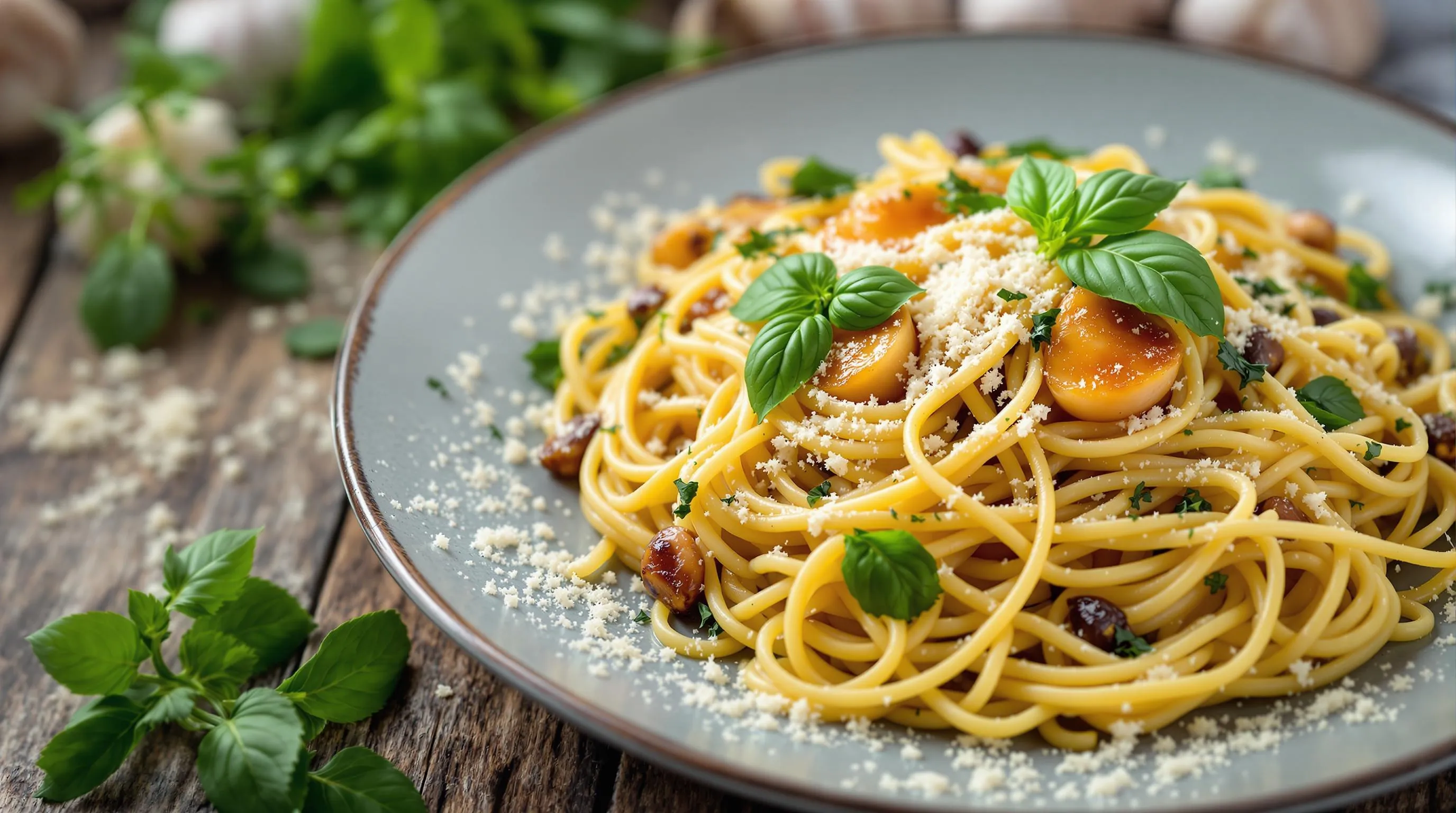
Creating the perfect garlic confit pasta relies on quality ingredients that work together to produce a rich and flavorful dish. The following components transform this simple pasta into a memorable meal that showcases the sweet mellow flavors of confit garlic.
Garlic Confit Components
- Garlic cloves: 25-35 peeled cloves (several full bulbs worth) form the heart of this dish
- Extra-virgin olive oil: Enough to completely submerge the garlic during cooking
- Fresh herbs (optional): A few sprigs of rosemary or thyme add aromatic depth
- Salt: Flaky sea salt or kosher salt to enhance the garlic’s natural sweetness
The magic happens when you cook these garlic cloves slowly at a low temperature (around 250°F) for up to 2 hours. This gentle cooking process transforms the sharp raw garlic into something completely different – soft caramelized cloves with a buttery texture and mellow flavor profile that will form the base of your pasta sauce.
Pasta and Sauce Ingredients
- Pasta: Select shapes that capture the sauce well such as pipette, rigatoni, fusilli, or bow-tie pasta
- Heavy cream: Creates silky richness that complements the garlic
- Cheese: Freshly grated Parmesan or Pecorino Romano adds savory depth
- Salted butter: Enhances the sauce’s luxurious texture
- Pasta water: Reserve some to help emulsify and thin the sauce as needed
- Seasonings: Black pepper and optionally red chili flakes for balanced heat
- Fresh basil: Adds bright herbal notes that cut through the richness
- Optional additions: Roasted cherry tomatoes, shallots, pine nuts, or burrata for complementary flavors and textures
These ingredients come together to create a pasta dish that balances creamy richness with complex garlic flavors. The beauty of this recipe lies in how each element supports the star of the show – those soft, sweet garlic cloves that have been transformed through the confit process. You’ll find that once you’ve mastered the basic technique, this dish offers endless possibilities for customization based on seasonal ingredients or personal preferences.
Equipment Needed
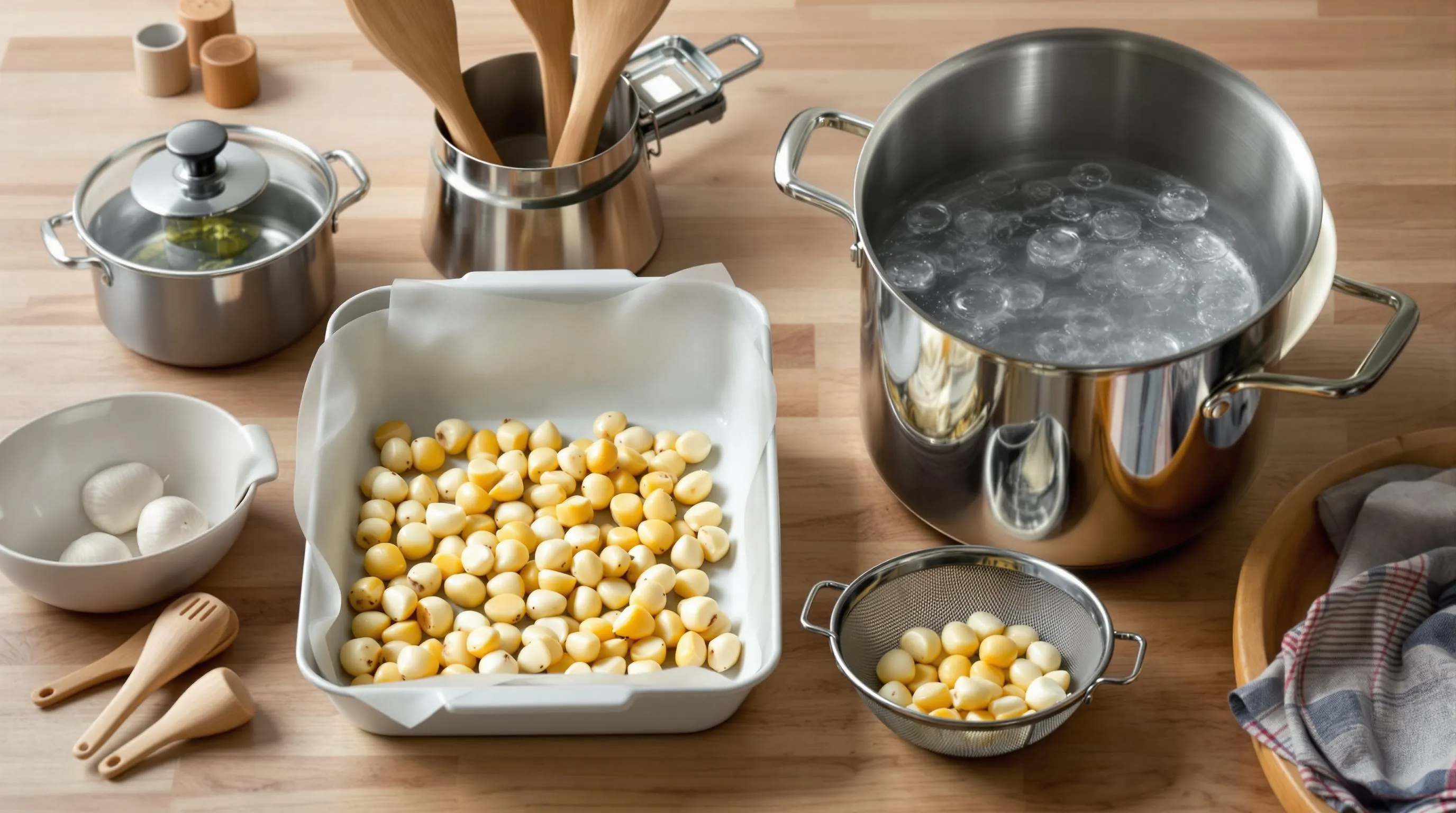
Preparing garlic confit pasta doesn’t require specialty cookware but having the right tools will ensure your cooking process flows smoothly. Here’s everything you’ll need to create this luxurious pasta dish:
- Oven or stovetop – For slow-roasting your garlic confit at approximately 400°F (204°C)
- Shallow baking dish or oven-safe container – To hold your garlic and oil during the confit process
- Large pot – For boiling your pasta to perfect al dente texture
- Strainer or colander – To drain your pasta while reserving some of that valuable pasta water
- Large pan or mixing bowl – For combining your pasta with the garlic confit sauce
- Fork – To gently mash the softened garlic cloves into a creamy consistency
- Measuring cups and spoons – For precise ingredient amounts
- Cooking utensils – Including wooden spoons, spatula, and tongs for stirring and serving
The beauty of this recipe lies in its simplicity – most home cooks already have these basic items in their kitchen. Your equipment doesn’t need to be fancy or expensive to achieve excellent results with garlic confit pasta. Having everything ready before you begin cooking will make the process even more enjoyable as you transform simple ingredients into a restaurant-worthy meal.
How to Make Garlic Confit
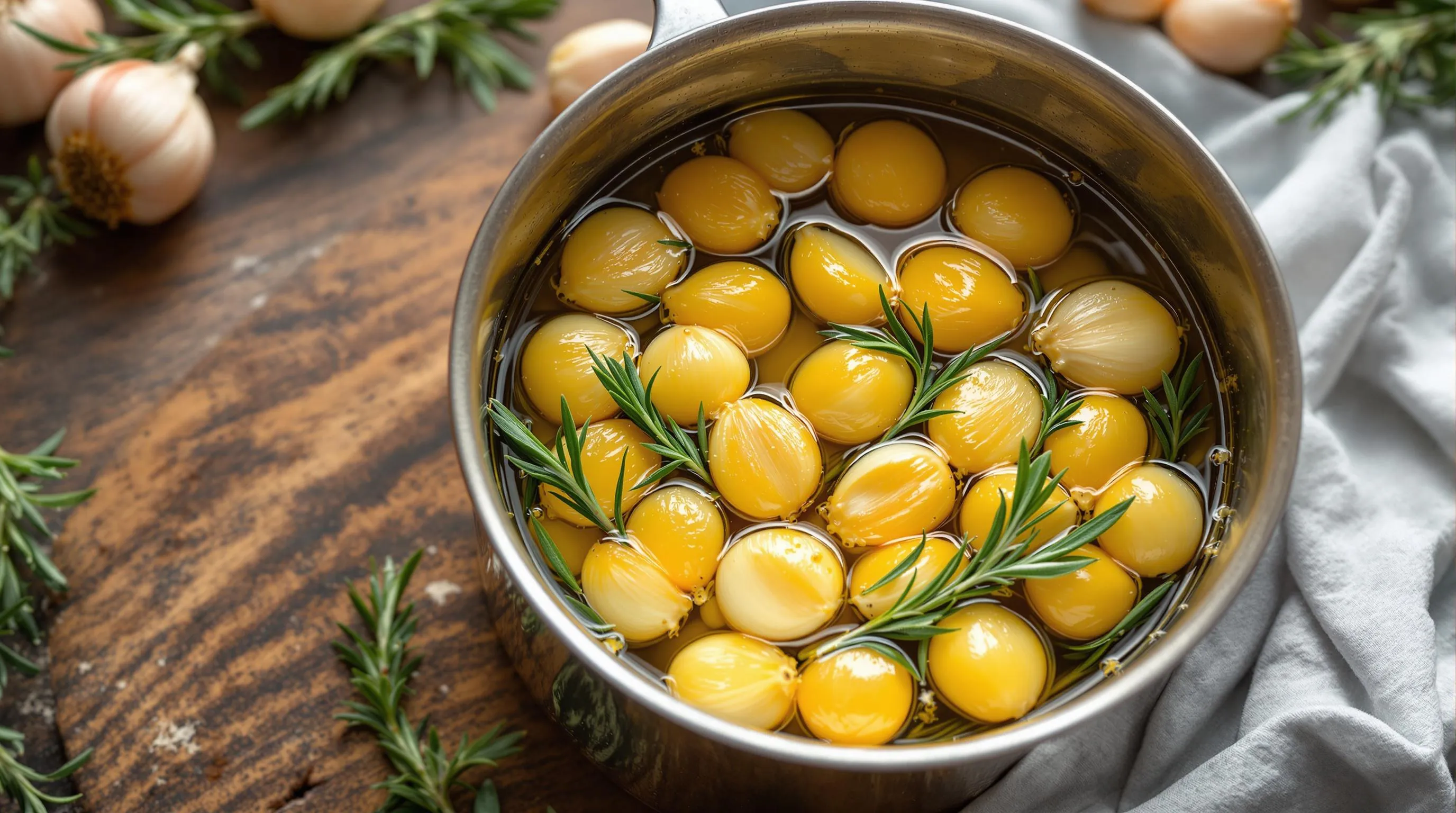
Creating garlic confit is a simple yet groundbreaking process that turns pungent garlic cloves into mellow, buttery delights. This technique forms the flavorful foundation of our pasta dish and requires just a few ingredients and some patience.
Preparing the Garlic
Start by gathering fresh heads of garlic for your confit. You’ll need to peel each clove while keeping them whole, which admittedly requires some time and patience. Fresh peeled cloves are essential for developing the best flavor in your confit, so avoid pre-peeled options if possible.
To make the peeling process easier, try soaking the separated cloves in warm water for 5-10 minutes. This simple trick helps loosen the skins and makes them slide off more readily. Alternatively, place the cloves in a microwave for about 20 seconds – the heat creates steam between the skin and clove, making them easier to peel.
Once all your garlic is peeled, inspect each clove and trim any brown spots or blemishes. The cleaner your garlic, the better your confit will taste and the longer it will keep.
Slow-Cooking Process
The key to perfect garlic confit lies in the gentle, slow cooking method that transforms the garlic’s flavor profile. Place your peeled garlic cloves in a saucepan or oven-safe dish and completely submerge them in extra-virgin olive oil.
For additional depth of flavor, add fresh aromatics to the oil. Sprigs of rosemary or thyme work beautifully, as do a few whole peppercorns or a bay leaf. These aromatics will infuse the oil as it cooks, creating layers of complementary flavors.
You have two excellent methods for cooking your garlic confit:
Stovetop Method: Set your burner to the lowest possible heat setting. The oil should barely shimmer – you’re looking for a very gentle simmer, not a boil or fry. Cook for 30 minutes to 1 hour, occasionally checking the garlic. Your cloves are ready when they’re soft and buttery but still hold their shape.
Oven Method: Preheat your oven to a very low temperature, between 195°F and 250°F. Place your oil-covered garlic in the oven, either covered or uncovered depending on your preference, and cook for 1-2 hours. The low, consistent heat of the oven provides excellent results with less monitoring.
Your garlic confit is done when the cloves are tender enough to be easily mashed with a fork but still maintain their structure. The color will have transformed from bright white to a creamy golden hue, and the once-sharp aroma will have mellowed considerably.
Allow the confit to cool slightly before using it in your pasta dish. Both the tender garlic cloves and the richly infused oil will become essential components of your sauce, creating that velvety texture and depth of flavor that makes garlic confit pasta so irresistible.
Making the Pasta Dish
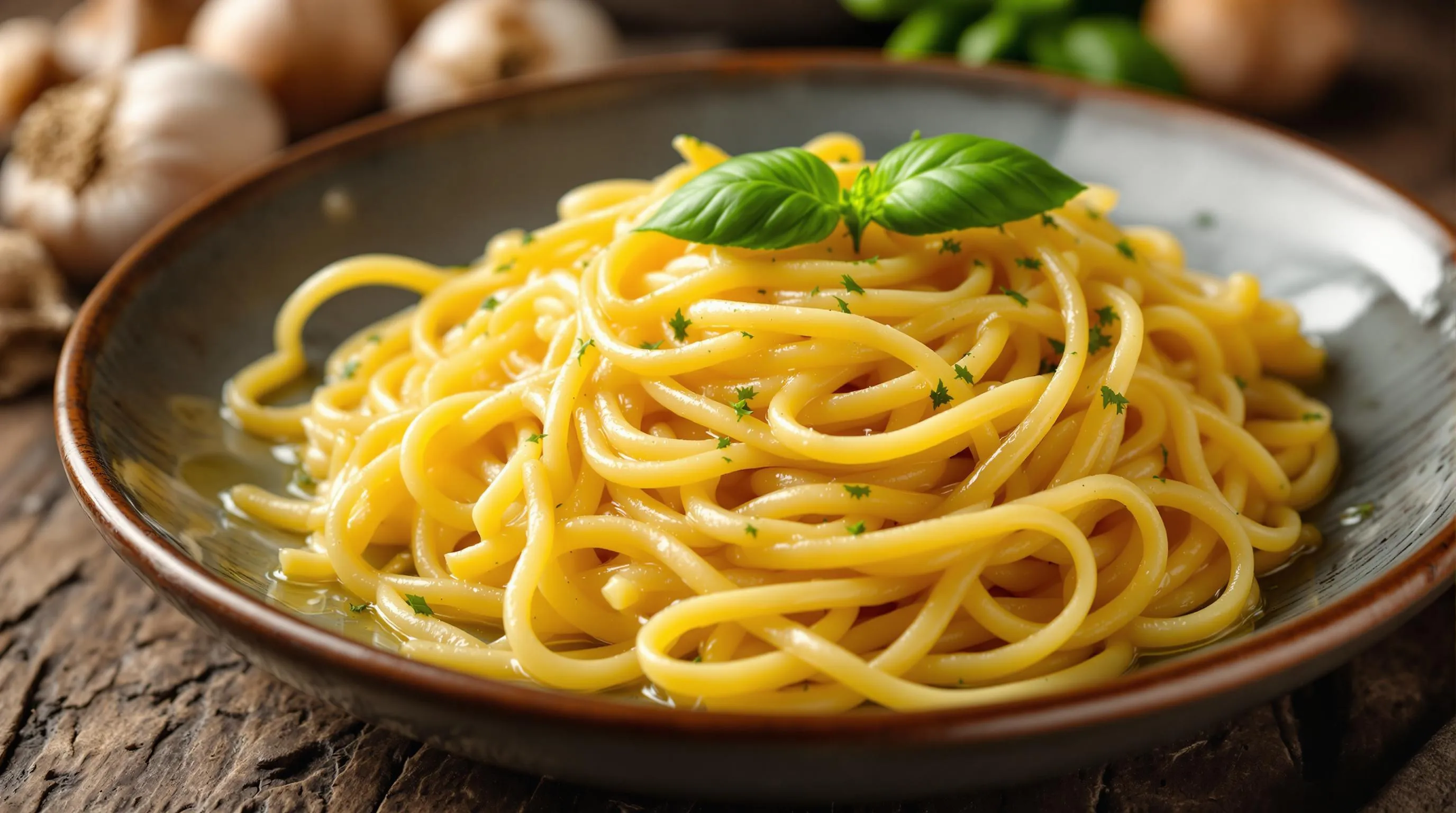
Transforming simple ingredients into a luxurious garlic confit pasta requires attention to detail and proper technique. Follow these steps to create a restaurant-worthy dish that showcases the mellow sweetness of garlic confit while achieving the perfect pasta texture and sauce consistency.
Cooking the Perfect Pasta
Start by bringing a large pot of water to a rolling boil. Add a generous amount of salt to the water—it should taste like seawater to properly season your pasta from within. Select your preferred pasta shape; linguine, spaghetti, or fettuccine work exceptionally well with this sauce as they provide ample surface area for the silky garlic sauce to cling to. Cook the pasta until it reaches the ideal al dente texture—tender yet still firm when bitten. This typically takes 1-2 minutes less than the package instructions suggest. Before draining, reserve about 1 cup of the starchy pasta water—this magical ingredient will help emulsify your sauce later. Drain the pasta but avoid rinsing it as the natural starches on the surface will help the sauce adhere better.
Creating the Silky Sauce
The foundation of your silky sauce begins with the garlic-infused oil from your confit. Heat 3-4 tablespoons of the garlic oil in a large pan over medium-low heat. For added richness, incorporate 2 tablespoons of salted butter until melted and combined with the oil. Your sauce can be customized with additional flavors like a sprinkle of red pepper flakes for heat or fresh herbs such as thyme or rosemary. For a creamier variation, add ¼ cup of heavy cream and ½ cup of freshly grated Parmesan cheese, stirring until smooth. The key to achieving that restaurant-quality silkiness lies in gradually adding the reserved pasta water—start with ¼ cup and add more as needed while stirring continuously. This creates the perfect emulsion that will coat each strand of pasta beautifully.
Incorporating the Garlic Confit
Take 8-10 cloves of your prepared garlic confit and gently mash them with the back of a fork to create a smooth paste. Add this garlic paste to your sauce base and stir thoroughly to distribute the mellow garlic flavor throughout. The softened garlic will practically melt into the sauce, creating a velvety texture with incredible depth. Transfer your cooked pasta directly to the sauce pan, tossing continuously to ensure even coating. Add more reserved pasta water as needed, 1-2 tablespoons at a time, until the sauce reaches a glossy consistency that clings to the pasta without pooling at the bottom of the pan. Finish with a squeeze of fresh lemon juice to brighten the flavors, a drizzle of extra garlic oil, and a garnish of fresh basil or chives. The final dish should showcase the transformed garlic—now sweet and buttery rather than sharp—in a sauce that hugs each strand of pasta perfectly.
Serving Suggestions
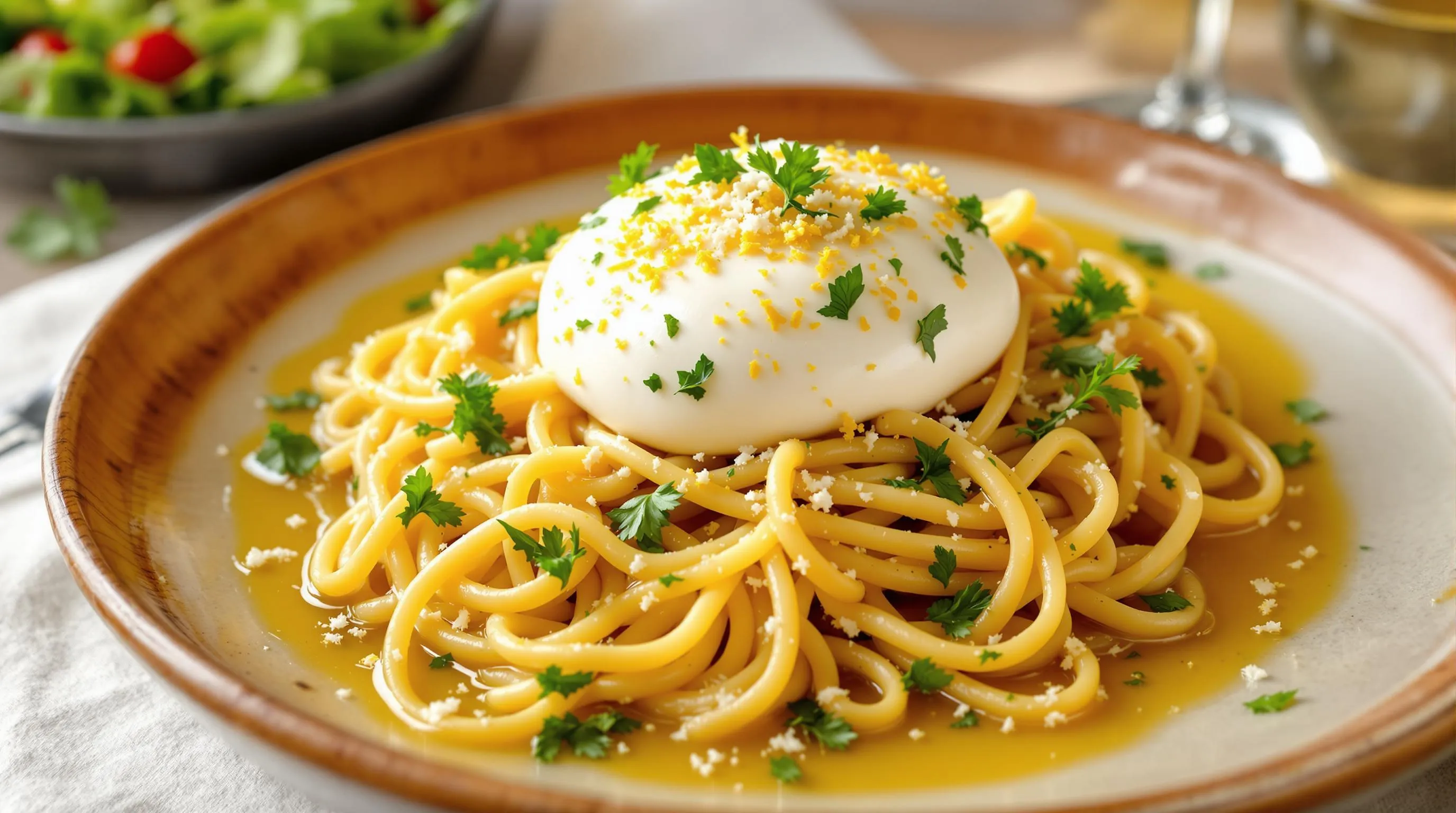
Transform your garlic confit pasta from a simple dish into an exceptional dining experience with these thoughtful serving suggestions that enhance its rich flavors and creamy texture.
Fresh grated cheese makes an immediate impact on this dish. Sprinkle Parmesan Reggiano or Pecorino Romano directly over the hot pasta to allow it to melt slightly into the silky sauce. The salty umami notes perfectly complement the sweet mellow garlic flavor that defines this dish.
Brighten your pasta with fresh herbs just before serving. Torn basil leaves add a fragrant aromatic quality while finely chopped chives provide a mild onion note that balances the buttery garlic. Consider adding a sprinkle of lemon zest for a citrusy lift that cuts through the richness of the sauce.
For an indulgent presentation that’s sure to impress dinner guests, place a ball of creamy burrata at the center of each serving. The cool creaminess of the cheese creates a delightful temperature contrast as it slowly melts into the warm pasta. Feta cheese offers a tangy alternative that works particularly well with versions including roasted tomatoes.
Remember to reserve some of your pasta cooking water. Adding a splash just before serving helps loosen the sauce if it becomes too thick while creating that restaurant-quality emulsion that coats each strand of pasta perfectly.
Your plating approach matters significantly with this elegant dish. Serve garlic confit pasta in warmed shallow bowls that showcase the glossy sauce and allow for easy twirling. A drizzle of the garlic-infused olive oil around the edge of the plate adds both visual appeal and an extra layer of flavor.
Pair this luxurious pasta with simple side dishes that won’t overwhelm its delicate flavors. A crisp green salad dressed lightly with lemon and olive oil provides refreshing contrast. Alternatively, simply roasted vegetables seasoned with just salt and pepper make ideal companions to this pasta’s rich complexity.
For wine pairings, opt for bottles that complement without competing. A medium-bodied white wine like Vermentino or Pinot Grigio works beautifully with creamier versions. Red wine enthusiasts might choose a light Chianti that won’t overpower the nuanced garlic flavors.
Serve your garlic confit pasta immediately after preparing for the best texture and temperature. The dish loses some of its magic as it cools so encourage guests to enjoy it while hot. This approach ensures they experience the full sensory pleasure of the velvety sauce coating each bite.
Storing Leftover Garlic Confit
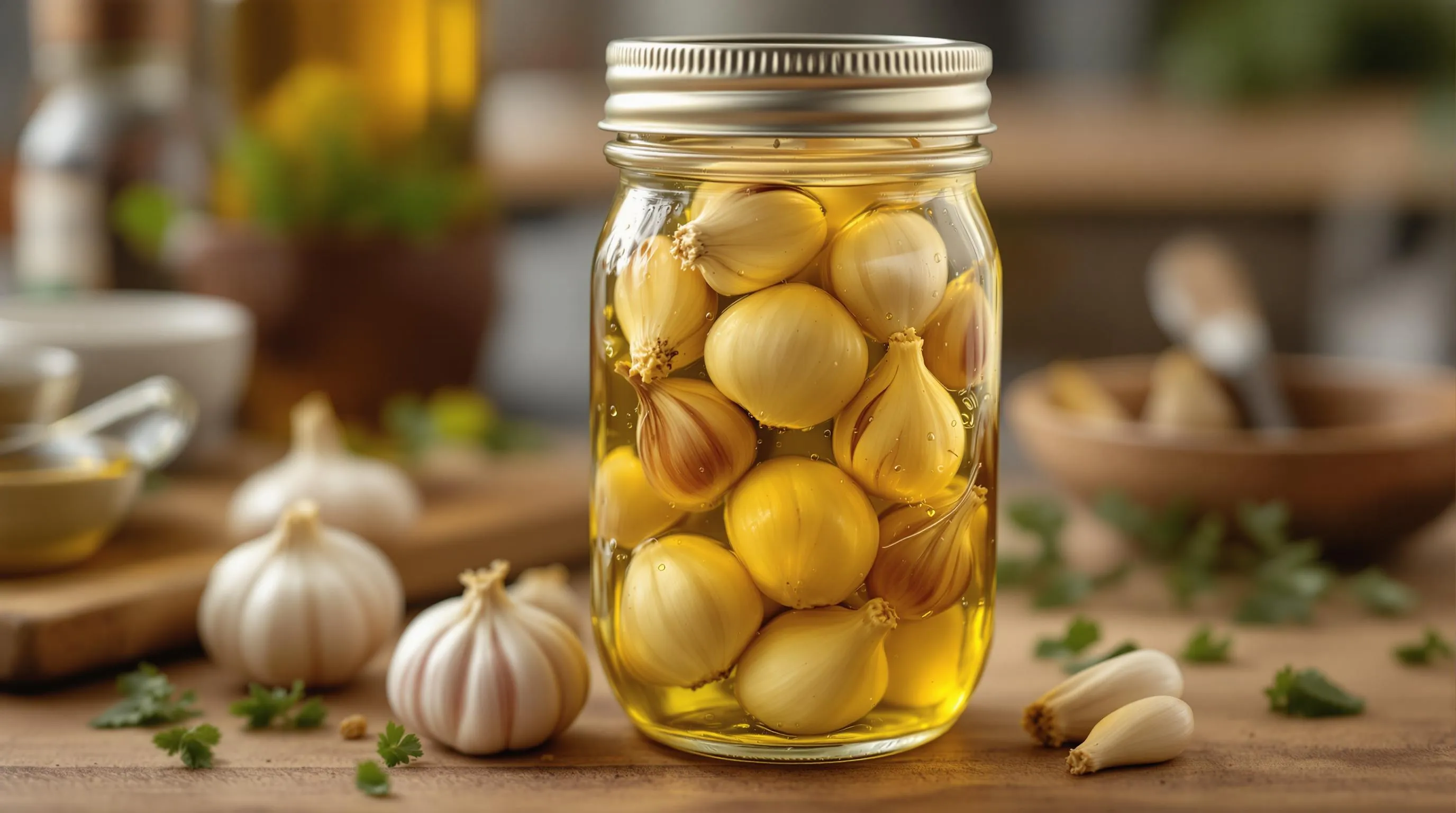
After creating your delicious garlic confit pasta you might find yourself with extra confit garlic and infused oil. Proper storage is crucial not only for preserving flavor but also for food safety reasons. The good news is that your leftover garlic confit can continue to enhance other meals throughout the week when stored correctly.
Always allow your garlic confit to cool completely to room temperature before transferring it to an airtight container. Mason jars work exceptionally well for this purpose as they create a perfect seal to keep flavors locked in and potential contaminants out.
Keep the garlic cloves fully submerged in the olive oil at all times. This complete submersion creates a protective barrier that prevents exposure to air which can lead to rapid spoilage and potential health risks.
Refrigeration is absolutely essential for garlic confit. Unlike some preserved foods the combination of garlic and oil creates an environment where botulism bacteria can potentially grow if left at room temperature. Your properly stored garlic confit will remain safe and flavorful in the refrigerator for up to four days.
For safety reasons never exceed the four-day storage recommendation regardless of how good it still looks or smells. The risk of botulism though rare is serious enough to warrant caution and respect for proper food handling guidelines.
Consider making smaller batches of garlic confit if you’re concerned about using it all within the safety window. This approach ensures you always have fresh confit when needed without waste or safety concerns.
The refrigerated oil may solidify slightly but will quickly return to its liquid state when brought back to room temperature or gently warmed. This solidification doesn’t affect the quality or flavor of your confit garlic or its infused oil.
Label your storage container with the date of preparation to help track freshness. This simple step eliminates guesswork and helps ensure you use your garlic confit within the safe timeframe.
Variations to Try
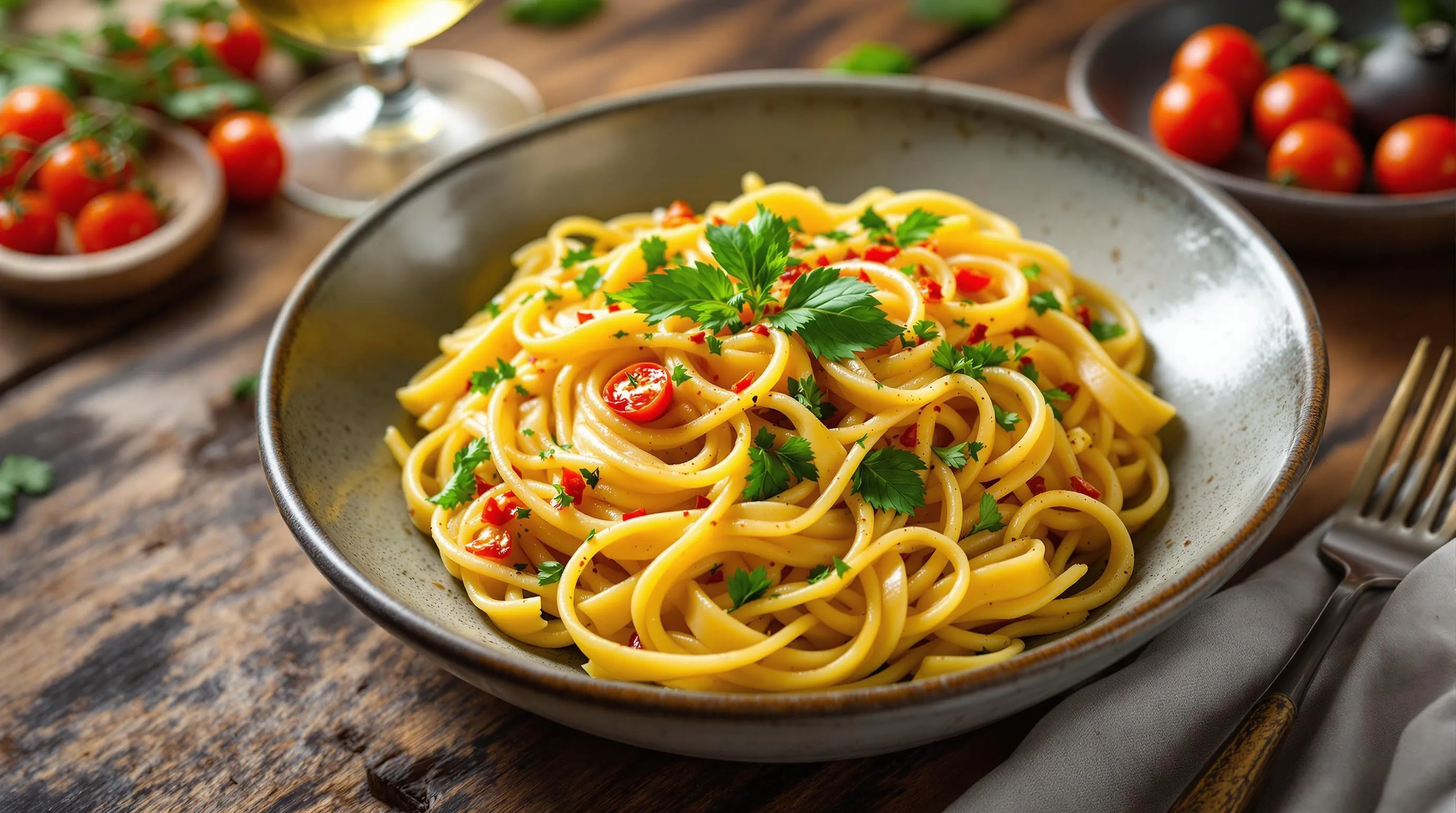
Once you’ve mastered the basic garlic confit pasta recipe, many delicious variations await your exploration. These adaptations build on the foundational flavors while introducing new dimensions to this already incredible dish.
Spicy Garlic Confit Pasta
Transform your garlic confit pasta into a fiery delight by incorporating heat elements that complement the mellow sweetness of the confited garlic. Add red pepper flakes directly to your garlic confit during the slow-cooking process to infuse the oil with a subtle warmth. For a more pronounced kick, mix chili flakes into your final sauce just before tossing with pasta. Fresh herbs like basil or chives create a beautiful flavor balance with the spice, adding brightness that cuts through the heat. Try incorporating the spicy garlic confit into a pesto sauce by mashing the confit cloves with pine nuts, fresh basil, Parmesan cheese, and some of that precious confit oil for a complex and zingy pasta topping.
Creamy Garlic Confit Pasta
Elevate your pasta dish to new heights of luxury by creating a silky, rich sauce that showcases the buttery garlic confit. Heavy cream forms the perfect base for this variation, melding beautifully with mashed garlic confit cloves and freshly grated Parmesan cheese. Roasted cherry tomatoes add delightful bursts of sweetness and acidity that cut through the richness of the cream. Another stunning approach combines the garlic confit with both cream and tomato for a blush sauce that coats each strand of pasta perfectly. Finish your creamy creation with an extra sprinkle of cheese and perhaps a touch of chili flakes for depth. This decadent version transforms even simple pasta into a restaurant-worthy dish that feels indulgent yet requires minimal effort to prepare.
Recipe Tips and Tricks
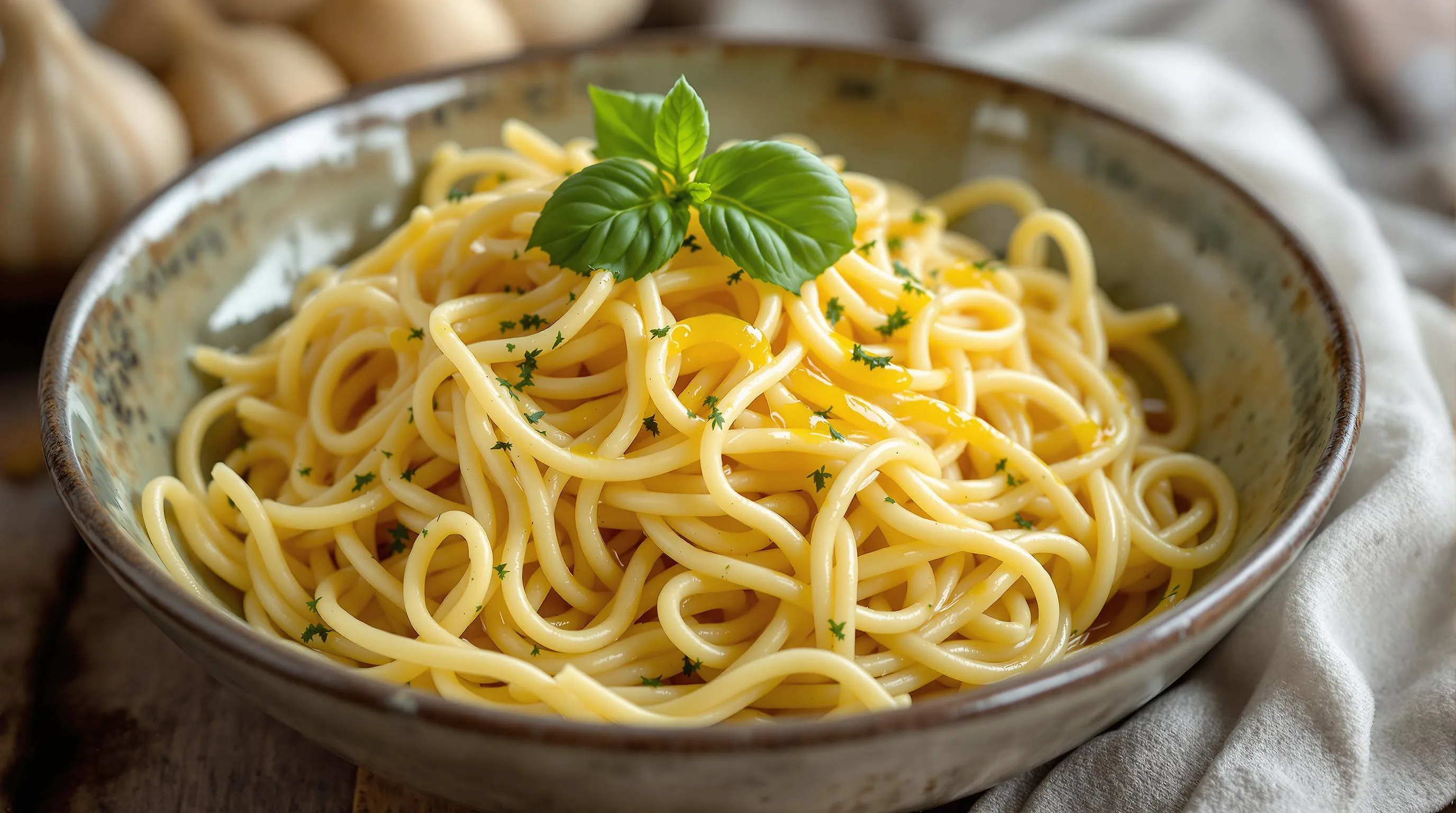
Perfect Your Garlic Confit
Achieving the ideal garlic confit requires patience and attention to temperature. Keep your heat consistently low—never exceeding 200°F—to develop sweetness without bitterness. The garlic should turn golden and butter-soft when pressed with a fork. Rushing this process risks bitter flavors that will compromise your entire dish.
Master the Pasta Technique
Reserve at least 1 cup of pasta water before draining your noodles. This starchy liquid acts as the secret ingredient that transforms your sauce from oily to silky-smooth. Add the reserved water gradually while tossing your pasta to create the perfect emulsion that clings to every strand.
Elevate Your Flavor Profile
Fresh herbs make all the difference in this deceptively simple dish. Thyme pairs beautifully with the confit during cooking, while basil or parsley added just before serving brings brightness that balances the rich garlic notes. For an extra dimension, finish with a squeeze of lemon juice to cut through the richness.
Storage Wisdom
Your garlic confit oil is liquid gold. Store any leftover confit cloves completely submerged in their oil to prevent oxidation and extend shelf life. This infused oil can transform simple dishes—try drizzling it over grilled bread, roasted vegetables, or use as the base for salad dressings.
Make-Ahead Strategy
Prepare your garlic confit in larger batches to save time on future meals. The confit process takes about two hours, but requires minimal hands-on attention. Once cooled, properly stored confit will maintain its quality in the refrigerator for up to four days, making weeknight cooking effortless.
Customize Thoughtfully
While the classic recipe shines in its simplicity, thoughtful additions can create exciting variations. Roasted cherry tomatoes burst with sweet acidity against the mellow garlic backdrop. A spoonful of creamy burrata melting into hot pasta creates an indulgent texture contrast that Liam Kohn discovered reminds him of his travels through northern Italy.
Temperature Matters
Serve your garlic confit pasta immediately after preparing for optimal texture. The sauce can thicken as it cools, potentially clumping rather than coating. If needed, rewarm with a splash of reserved pasta water while gently tossing to revive its silky consistency.
The Perfect Wine Pairing
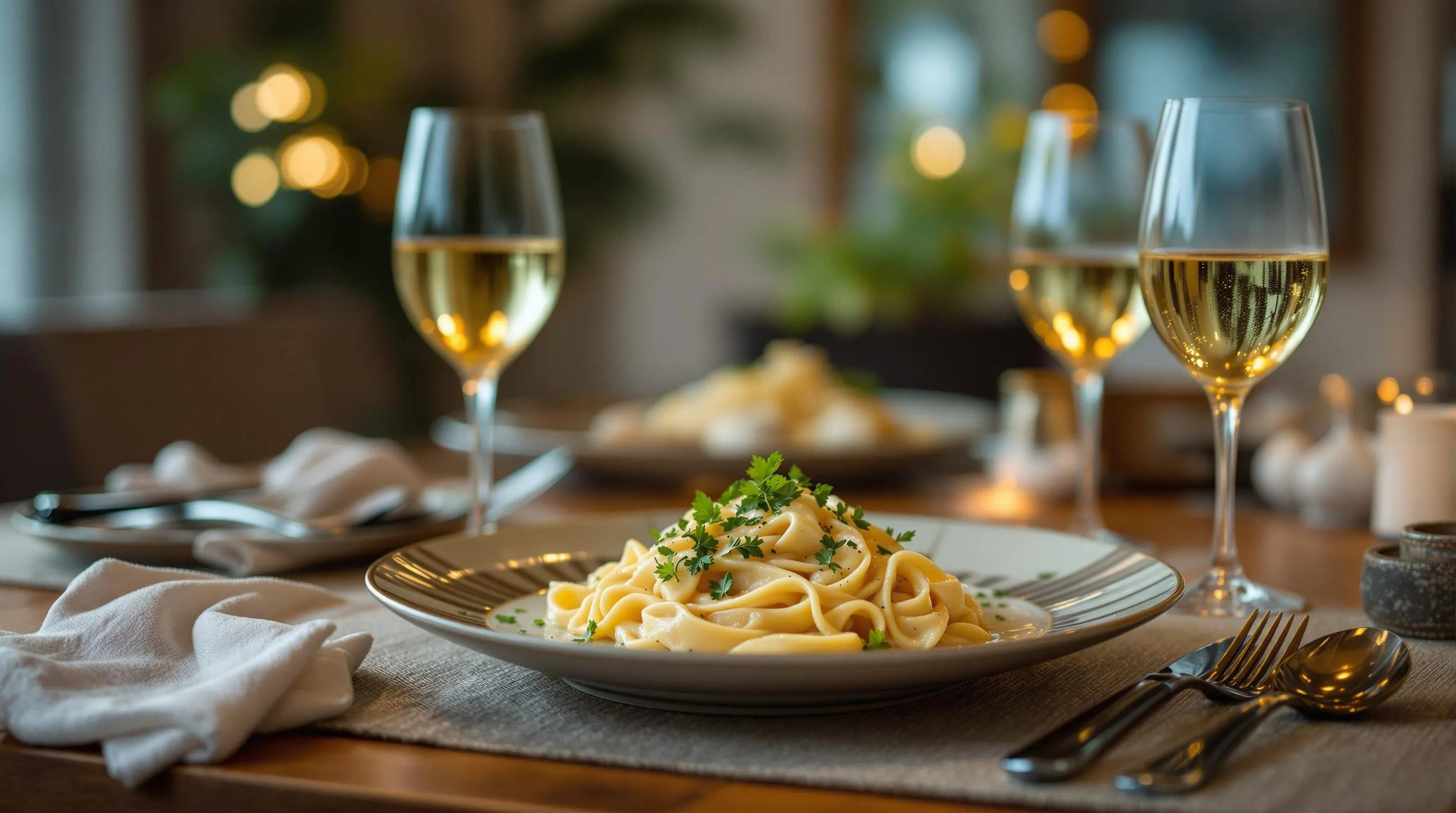
Selecting the right wine for your garlic confit pasta elevates this already luxurious dish to new heights. The transformed sweetness of slow-cooked garlic combined with the rich creaminess of the sauce creates a flavor profile that pairs beautifully with wines that offer bright acidity to cut through the richness.
For creamy garlic confit pasta preparations like Pasta alla Vodka, a well-balanced Chardonnay provides the perfect counterpoint. Its crisp characteristics refresh your palate between bites while complementing the mellow garlic notes that define this dish. Pinot Gris also works exceptionally well, offering enough body to stand up to the sauce without overwhelming the delicate flavors you’ve developed during the confit process.
When serving a lighter version of garlic confit pasta with less cream and more emphasis on the olive oil-based sauce, consider reaching for an off-dry Riesling. The slight sweetness and pronounced fruitiness beautifully complement the buttery garlic flavors while the wine’s natural acidity balances the olive oil components.
Many guests at my cooking workshops express surprise at how groundbreaking the right wine pairing can be with this dish. As one participant noted, “The bubbles in the sparkling wine you suggested completely refreshed my palate between bites, making each forkful taste as exciting as the first.”
| Pasta Style | Recommended Wine(s) | Why It Works |
|---|---|---|
| Garlic Confit Pasta alla Vodka | Chardonnay, Pinot Gris | Crispness cuts through creamy sauce while complementing garlic sweetness |
| Lighter Garlic Confit with Olive Oil | Riesling | Fruitiness enhances garlic notes while acidity balances the oil |
| Any Garlic Confit Pasta Variation | Sparkling Wine | Bubbles refresh the palate between rich bites |
For special occasions, don’t hesitate to open a bottle of quality sparkling wine – its effervescence works wonders against the silky texture of the pasta sauce. The contrasting textures create a sensory experience that highlights both the wine and your carefully prepared dish.
Remember that serving temperature matters significantly when pairing wine with garlic confit pasta. White wines should be properly chilled but not ice-cold to allow their aromatic qualities to shine through and complement the aromatic nature of your garlic-infused creation.
Conclusion
Garlic confit pasta transforms an everyday ingredient into something extraordinary. This dish proves that culinary magic often lies in technique rather than complexity. You’ll find the mellow sweetness of slow-cooked garlic creates a pasta experience that’s both comforting and sophisticated.
Whether you stick with the classic preparation or explore creative variations with spice or cream you’re creating something that truly transcends its humble ingredients. The beauty of this dish is in its adaptability to your preferences and pantry.
Next time you’re craving pasta that’s a cut above the ordinary reach for those garlic cloves and good olive oil. Your kitchen will fill with irresistible aromas and you’ll discover why this dish has become a beloved staple for home cooks and chefs alike.
